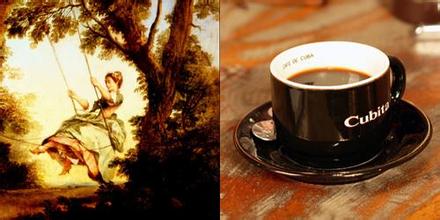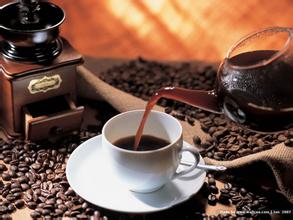Starbucks doesn't sell coffee and starts selling alcohol?
Coffee is exhilarating, beer is sorrowful; coffee is bittersweet, beer is sweet. These two kinds of drinks sound like two worlds, but they have quietly collided with sparks.
This alcoholic beverage "Espresso Cloud? Literally, "IPA" seems to be made from Espresso (espresso), but it is paired with refined beer and presented in a whole new way.
The alcoholic beverage is made by Starbucks coffee guru Justin Burns-Beach and is inspired by an Italian cold coffee called Shakerato. Shake in a shaker with special espresso, ice cubes and syrup, then separate the ice and pour out.
After production, the cup will be full of soft foam, taste as smooth as silk, quite popular with Coffee Geek. The speed and technique of shaking have high requirements for the skill of baristas. For a more detailed taste, Starbucks also adds orange and vanilla elements to its espresso.
Why did Starbucks launch this new product at this time?
In recent years, on the one hand, many excellent boutique cafes in the United States have extended the tentacles of product development beyond coffee. Coffee X Beer has become the highlight of product development in the top independent cafes in the United States. On the other hand, in the face of the pressure from the crazy expansion of McCoffee and the slowing down of the growth rate of its traditional business, Starbucks naturally caught this hidden consumption hot spot in time. This new product that combines coffee and refined coffee is a move to keep the market young.
It is reported that this gimmick drink "Espresso Cloud?" "IPA" will be added to Starbucks' night menu. At present, it is only available for 32 stores in the United States, including Seattle, Los Angeles, Chicago and other cities.
15% Muay 20% of beverage sales contribute 50% of the profits of the entire restaurant, according to a consumer dining out report submitted by Mintel this year.
It is no longer unusual for beverages and drinks to be profitable, but although businesses are clear about it, they have failed to make beverages and drinks lag far behind in the catering industry.
The former table heroes are now uncles. According to statistics, half of these heavy consumers who drink liquor at least once a day are over 45 years old, and 44% belong to the bottom of society. Their spending power is obviously not as active as consumers between the ages of 25 and 44. Not only that, their habit of buying wine from restaurants has become a dealer or convenience store.
If you look at the 25-44-year-old group, they are obviously more interested in foreign wine, and their heavy consumers have reached 91%. Followed by wine 73%, beer 70%, while once the scenery of liquor, heavy consumers now account for only 47%.
It is also a drink, but the consumption purpose of modern young people will be more direct. They choose Starbucks to find comfortable space, convenience stores for economy, fresh fruit juices for healthy living, or just to relax and drink and go to bars for a long time.
It is clear that businesses that clearly and quickly solve their problems or needs will be more popular. Therefore, when they go to a restaurant, they prefer to enjoy the delicious food rather than unexpectedly high-priced wine or juice, not to mention that they do not feel at ease when they do not see the production process with their own eyes. these will be the reason for them to deliberately skip the wine bar when ordering.
By the way, there is also online in addition to offline. While the "Internet" has become the preferred platform for young people to buy alcohol (especially wine), the lives of drinks are somewhat worrying, because the rise of takeout services means that people are less likely to order drinks.
If consumers are more concerned about the brand and taste of the wine, then there are more places where drinks make themselves look "very high-end".
Modern labels such as "organic, pure natural, healthy, handmade, zero add", or can give consumers a glimpse of all kinds of described functional drinks, even soda water and high-grade bottled mineral water. can effectively shift their focus on products from price to value, thus making them pay more.
Just as Starbucks bought TEAVANA at a high price to enter the tea market, the lineup of domestic craft beer became stronger (represented by Panda Fine Brewing, Dayue and Jing A), and the category of high-priced fruit juices in convenience stores proliferated. Even fast-food chains like McDonald's, Shake Shack and Burger King have not missed the opportunity to make themselves stand out with drinks and drinks, such as selling alcohol.
Starbucks can make a whole tea-loving China infatuated with coffee, in addition to the surface characteristics such as customer experience and store environment, what is more powerful is the underlying marketing to employees-turning each employee into a Starbucks fan and owner.
However, the most important point is whether you can get exclusive, high-quality, low-cost resources. It determines the activity of your customers and, of course, how many tickets you end up putting in your pocket. Take the charcoal craftsman, for example, some of its wines are updated every three or four months, in addition to looking at the popular trend of the Japanese beverage market, it actually depends more on the ability of the suppliers.
For Coffee Starbucks, Starbucks is almost synonymous with (weekday) coffee, but some of its recent moves are pushing itself further and further away from the coffee label.
The "Starbucks Evening" project, which has been tested for some time in some stores in Canada and the United States, was officially launched in August. As the name suggests, Starbucks wants to find a reason why you still shop at night, and the temptation they offer is "wine".
Now in 75 stores in North America, you can buy wine or beer after 16: 00, or even bacon rolls, kebabs and Pizza.
In terms of improving the operational efficiency of its stores, there is nothing wrong with Starbucks making these new attempts. And with the quality control and brand of Starbucks, there are likely to be many consumers to taste Brunch food and beverage products after they are officially on the market. But there are also some foreseeable hidden dangers behind these attempts.
First of all, Starbucks has never only sold coffee, but has always had tea, carbonated drinks and other products. However, Starbucks drinks are after all "Starbucks products", regardless of the quality of the products, there is no problem to make relative differentiation. Red wine or beer is absolutely standard, and a beer bought at Starbucks or any other store has the same taste. This may be of limited appeal to some consumers.
In addition, selling alcoholic beverages may be a potential brand damage. To some extent, Starbucks represents a relatively healthy and active lifestyle (it's true that coffee is not a healthy choice for everyone; but at least, start the day with a refreshing cup of coffee, this represents a psychological implication of being positive about life and work). If Starbucks is strongly bound to the label "alcohol", it may be a less attractive thing for family customers and students. Imagine when Starbucks in China also started selling beer and chicken kebabs. Do not rule out the possibility that someone will come to Starbucks for a barbecue and drink too much to make trouble.
But overall, finding ways to make more money from food or at night is a worthwhile direction for Starbucks. According to the data we have collected, Starbucks currently derives 19% of its revenue from food, and aims to double its food revenue in the United States to $4 billion by 2019.
The above content is shared from shopkeeper strategy, 36Kr, and pushed by Yingshi China's official Wechat. Thank you for subscription. For more highlights, please follow Insite or log on to the micro community platform to participate in the interaction.
Welcome to search for @ Yingshi China's official Weibo
With more than 10 years of operation experience and service network, Yingshi China Commercial Investment holding Group provides one-stop business operation mode and whole-process solution for the project by innovating the operation platform of commercial retail real estate.

Important Notice :
前街咖啡 FrontStreet Coffee has moved to new addredd:
FrontStreet Coffee Address: 315,Donghua East Road,GuangZhou
Tel:020 38364473
- Prev

Global climate anomaly coffee bean futures rise sharply over oil and gold
Media aid quoted the US financial news network MarketWatch reported that the commodity market has greatly improved this year, but the outside world has mostly focused on crude oil and gold, but they do not realize that the rise of soft commodities is stronger than that of oil gold, among which the price of coffee has risen by about 25% since the theme of climate change. Market analysts continue to be optimistic about the future, and it is estimated that there is still 25% room to rise before the end of the year.
- Next

"Coffee Apple" is quietly setting off a technological revolution.
Blue Bottle, a famous coffee shop known as Apple, is famous for its anti-fast food and slow coffee. Many people think that the blue bottle is synonymous with good appearance and high quality, but they do not know that it always pursues perfection and more different possibilities in the innovation of the coffee industry. There is no high-end advertisement for the acquisition of Perfect Coffee, and the rhythm of new product push is low-key and unobtrusive.
Related
- What ratio of water temperature and ground does the smart cup method use to press coffee? The difference between brewed coffee and filtered coffee?
- What is the standard process for the purpose of coffee cup testing? What is the difference between hand-brewed coffee and cup testing?
- How to use hand-brewed coffee paragon small golden balls? How does cold coffee lock in the aroma of coffee?
- Is American coffee black? What is the difference between American coffee and drip coffee?
- Unexpected! Well-known tea beverage brand Lele Tea will withdraw from the Zhengzhou market!
- Starbucks enters the fashion and beauty industry?! Netizen: Give me an ice American eye cream
- Why can American refills for free? The difference between Americano and American drip pot coffee
- Being chased out of the rain in front of Starbucks?! Store: Sheltering from rain under umbrellas poses a safety hazard
- The white moonlight has changed?! Lucky launches "Big Winter Pear American"
- Hand-brewed coffee three-stage method, high-sweet and universal brewing method to share! What does the high sweet water level of hand-brewed coffee mean?

